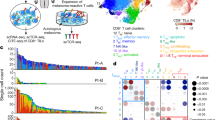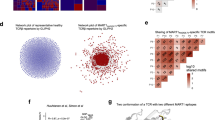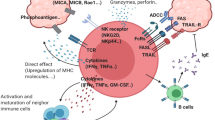Abstract
We identified circulating CD8+ T-cell populations specific for the tumor-associated antigens (TAAs) MART-1 (27-35) or tyrosinase (368-376) in six of eleven patients with metastatic melanoma using peptide/HLA-A*0201 tetramers. These TAA-specific populations were of two phenotypically distinct types: one, typical for memory/effector T cells; the other, a previously undescribed phenotype expressing both naive and effector cell markers. This latter type represented more than 2% of the total CD8+ T cells in one patient, permitting detailed phenotypic and functional analysis. Although these cells have many of the hallmarks of effector T cells, they were functionally unresponsive, unable to directly lyse melanoma target cells or produce cytokines in response to mitogens. In contrast, CD8+ T cells from the same patient were able to lyse EBV-pulsed target cells and showed robust allogeneic responses. Thus, the clonally expanded TAA-specific population seems to have been selectively rendered anergic in vivo. Peptide stimulation of the TAA-specific T-cell populations in other patients failed to induce substantial upregulation of CD69 expression, indicating that these cells may also have functional defects, leading to blunted activation responses. These data demonstrate that systemic TAA-specific T-cell responses can develop de novo in cancer patients, but that antigen-specific unresponsiveness may explain why such cells are unable to control tumor growth.
This is a preview of subscription content, access via your institution
Access options
Subscribe to this journal
Receive 12 print issues and online access
$209.00 per year
only $17.42 per issue
Buy this article
- Purchase on Springer Link
- Instant access to full article PDF
Prices may be subject to local taxes which are calculated during checkout






Similar content being viewed by others
References
Yannelli, J.R. et al. Growth of tumor-infiltrating lymphocytes from human solid cancers: summary of a 5-year experience. Int. J. Cancer 65, 413–421 (1996).
Topalian, S.L., Solomon, D. & Rosenberg, S.A. Tumor-specific cytolysis by lymphocytes infiltrating human melanomas. J. Immunol. 142, 3714– 3725 (1989).
Romero, P. et al. Ex vivo staining of metastatic lymph nodes by class I major histocompatibility complex tetramers reveals high numbers of antigen-experienced tumor-specific cytolytic T lymphocytes. J. Exp. Med. 188, 1641–1650 (1998).
Altman, J.D. et al. Phenotypic analysis of antigen-specific T lymphocytes. Science 274, 94–96 ( 1996).
McMichael, A.J. & O'Callaghan, C.A. A new look at T cells. J. Exp. Med. 187, 1367– 1371 (1998).
Kawakami, Y. & Rosenberg, S.A. Human tumor antigens recognized by T-cells. Immunol. Res. 16, 313– 339 (1997).
Cormier, J.N. et al. Heterogeneous expression of melanoma-associated antigens and HLA-A2 in metastatic melanoma in vivo. Int. J. Cancer 75, 517–524 (1998).
Boon, T. et al. Genes coding for tumor rejection antigens: perspectives for specific immunotherapy. Important Adv. Oncol. 130, 53–69 (1994).
Rosenberg, S.A. & White, D.E. Vitiligo in patients with melanoma: normal tissue antigens can be targets for cancer immunotherapy. J. Immunother. 19, 81– 84 (1996).
Ogg, G.S., Dunbar, P.R., Romero, P., Chen, J.L. & Cerundolo, V. High Frequency of Skin-homing Melanocyte-specific Cytotoxic T Lymphocytes in Autoimmune Vitiligo. J. Exp. Med. 188, 1203–1208 (1998).
Bell, E.B., Sparshott, S.M. & Bunce, C. CD4+ T-cell memory, CD45R subsets and the persistence of antigen—a unifying concept. Immunol. Today 19, 60–64 (1998).
Natali, P.G. et al. Selective changes in expression of HLA class I polymorphic determinants in human solid tumors. Proc. Natl. Acad. Sci. USA 86, 6719–6723 ( 1989).
Maeurer, M.J. et al. Tumor escape from immune recognition: lethal recurrent melanoma in a patient associated with downregulation of the peptide transporter protein TAP-1 and loss of expression of the immunodominant MART-1/Melan-A antigen. J. Clin. Invest. 98, 1633– 1641 (1996).
Callan, M.F. et al. Direct visualization of antigen-specific CD8+ T cells during the primary immune response to Epstein-Barr virus in vivo. J. Exp. Med. 187, 1395–1402 (1998).
Hamann, D. et al. Phenotypic and functional separation of memory and effector human CD8+ T cells. J. Exp. Med. 186, 1407 –1418 (1997).
Trimble, L.A. & Lieberman, J. Circulating CD8 T lymphocytes in human immunodeficiency virus-infected individuals have impaired function and downmodulate CD3 zeta, the signaling chain of the T-cell receptor complex. Blood 91, 585–594 (1998).
Ku, C.C., Kotzin, B., Kappler, J. & Marrack, P. CD8+ T-cell clones in old mice. Immunol. Rev. 160, 139– 144 (1997).
Lahat, N., Rahat, M.A., Sadeh, O., Kinarty, A. & Kraiem, Z. Regulation of HLA-DR and costimulatory B7 molecules in human thyroid carcinoma cells: differential binding of transcription factors to the HLA-DRalpha promoter. Thyroid 8, 361–369 (1998).
Barth, R.J., Jr., Camp, B.J., Martuscello, T.A., Dain, B.J. & Memoli, V.A. The cytokine microenvironment of human colon carcinoma. Lymphocyte expression of tumor necrosis factor-alpha and interleukin-4 predicts improved survival. Cancer 78, 1168–1178 (1996).
Kawakami, Y. et al. Identification of the immunodominant peptides of the MART-1 human melanoma antigen recognized by the majority of HLA-A2-restricted tumor infiltrating lymphocytes. J. Exp. Med. 180, 347–352 (1994).
Sundstedt, A. et al. Superantigen-induced anergy in cytotoxic CD8+ T cells. J. Immunol. 154, 6306–6313 (1995).
Chai, J.G., Bartok, I., Scott, D., Dyson, J. & Lechler, R. T:T antigen presentation by activated murine CD8+ T cells induces anergy and apoptosis. J. Immunol. 160 , 3655–3665 (1998).
Mizoguchi, H. et al. Alterations in signal transduction molecules in T lymphocytes from tumor-bearing mice. Science 258, 1795 –1798 (1992).
Ochoa, A.C. & Longo, D.L. Alteration of signal transduction in T cells from cancer patients. Imp. Adv. Oncol. 55 , 43–54 (1995).
Finke, J.H. et al. Loss of T-cell receptor zeta chain and p56lck in T-cells infiltrating human renal cell carcinoma. Cancer Res. 53, 5613–5616 (1993).
Nakagomi, H. et al. Decreased expression of the signal-transducing zeta chains in tumor-infiltrating T-cells and NK cells of patients with colorectal carcinoma. Cancer Res. 53, 5610–5612 (1993).
He, X.S. et al. Quantitative analysis of hepatitis C virus-specific CD8+ T cells in peripheral blood and liver using peptide-MHC tetramers. Proc. Natl. Acad. Sci. USA (in the press).
Chambers, C.A. & Allison, J.P. Co-stimulation in T cell responses. Curr. Opin. Immunol. 9, 396–404 (1997).
Sperling, A.I. et al. CD28/B7 interactions deliver a unique signal to naive T cells that regulates cell survival but not early proliferation. J. Immunol. 157, 3909–3917 ( 1996).
Huang, A.Y. et al. Role of bone marrow-derived cells in presenting MHC class I-restricted tumor antigens. Science 264, 961–965 (1994).
Huang, A.Y. et al. Bone marrow-derived cells present MHC class I-restricted tumour antigens in priming of antitumour immune responses. Ciba Found. Symp. 187, 229–240; discussion 240– 224 (1994).
Marrogi, A.J. et al. Study of tumor infiltrating lymphocytes and transforming growth factor-beta as prognostic factors in breast carcinoma. Int. J. Cancer 74, 492–501 ( 1997).
Merogi, A.J. et al. Tumor-host interaction: analysis of cytokines, growth factors, and tumor-infiltrating lymphocytes in ovarian carcinomas. Hum. Pathol. 28, 321–331 ( 1997).
Zajac, A.J. et al. Viral immune evasion due to persistence of activated T cells without effector function. J. Exp. Med. 188, 2205–2213 (1998).
DeGrendele, H.C., Estess, P. & Siegelman, M.H. Requirement for CD44 in activated T cell extravasation into an inflammatory site. Science 278, 672–675 (1997).
Beagley, K.W. & Husband, A.J. Intraepithelial lymphocytes: origins, distribution, and function. Crit. Rev. Immunol. 18, 237–254 (1998).
Rocha, B., Vassalli, P. & Guy-Grand, D. Thymic and extrathymic origins of gut intraepithelial lymphocyte populations in mice. J. Exp. Med. 180, 681–686 (1994).
Kaminski, M.J., Cruz, P.D., Jr., Bergstresser, P.R. & Takashima, A. Killing of skin-derived tumor cells by mouse dendritic epidermal T-cells. Cancer Res. 53, 4014– 4019 (1993).
Shiohara, T. & Moriya, N. Epidermal T cells: their functional role and disease relevance for dermatologists. J. Invest. Dermatol. 109, 271–275 ( 1997).
Yee, C., Riddell, S.R. & Greenberg, P.D. Prospects for adoptive T cell therapy. Curr. Opin. Immunol. 9, 702–708 (1997).
Maio, M. & Parmiani, G. Melanoma immunotherapy: new dreams or solid hopes? Immunol. Today 17, 405– 407 (1996).
Maeurer, M.J., Storkus, W.J., Kirkwood, J.M. & Lotze, M.T. New treatment options for patients with melanoma: review of melanoma-derived T-cell epitope-based peptide vaccines. Melanoma Res. 6, 11–24 (1996).
Lee, N. et al. HLA-E is a major ligand for the natural killer inhibitory receptor CD94/NKG2A. Proc. Natl. Acad. Sci. USA 95, 5199–5204 (1998).
Coulie, P.G. et al. A new gene coding for a differentiation antigen recognized by autologous cytolytic T lymphocytes on HLA-A2 melanomas. J. Exp. Med. 180, 35–42 ( 1994).
Riddell, S.R., Reusser, P. & Greenberg, P.D. Cytotoxic T cells specific for cytomegalovirus: a potential therapy for immunocompromised patients. Rev. Infect. Dis. 13 Suppl 11, S966–973 (1991).
Yee, C. et al. Isolation of tyrosinase-specific CD8+ and CD4+ T cell clones from the peripheral blood of melanoma patients following in vitro stimulation with recombinant vaccinia virus. J. Immunol. 157, 4079–4086 (1996).
Acknowledgements
We thank P. Roche (Mayo Clinic, Rochester, Minnesota) for the immunohistochemical staining of the tumor biopsy from patient 017; X.-S. He for suggesting the CD69 upregulation assay; and S. DeRosa, M. Mengozzi for discussions and J. Mumm and I. Tjioe for technical assistance. P.P.L. is supported by a physician-scientist award from the NIH (K08 CA72976). C.Y. is supported by the Burroughs Wellcome Fund Career Award and the NIH. P.A.S. is a Howard Hughes Medical Institute predoctoral fellow. M.R. is supported by NIH grants CA-42509 and CA-81543. This study was funded by grants from the Howard Hughes Medical Institute and the National Institutes of Health to M.M.D.
Author information
Authors and Affiliations
Corresponding author
Rights and permissions
About this article
Cite this article
Lee, P., Yee, C., Savage, P. et al. Characterization of circulating T cells specific for tumor-associated antigens in melanoma patients. Nat Med 5, 677–685 (1999). https://doi.org/10.1038/9525
Received:
Accepted:
Issue Date:
DOI: https://doi.org/10.1038/9525
This article is cited by
-
Emerging hallmark of gliomas microenvironment in evading immunity: a basic concept
The Egyptian Journal of Neurology, Psychiatry and Neurosurgery (2023)
-
Multiple instance neural networks based on sparse attention for cancer detection using T-cell receptor sequences
BMC Bioinformatics (2022)
-
Peripheral T cell cytotoxicity predicts the efficacy of anti-PD-1 therapy for advanced non-small cell lung cancer patients
Scientific Reports (2022)
-
Proteogenomic discovery of neoantigens facilitates personalized multi-antigen targeted T cell immunotherapy for brain tumors
Nature Communications (2021)
-
Metabolic barriers to cancer immunotherapy
Nature Reviews Immunology (2021)



